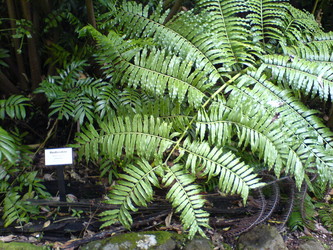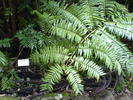Ptisana
Maarten Christenhusz


This tree diagram shows the relationships between several groups of organisms.
The root of the current tree connects the organisms featured in this tree to their containing group and the rest of the Tree of Life. The basal branching point in the tree represents the ancestor of the other groups in the tree. This ancestor diversified over time into several descendent subgroups, which are represented as internal nodes and terminal taxa to the right.

You can click on the root to travel down the Tree of Life all the way to the root of all Life, and you can click on the names of descendent subgroups to travel up the Tree of Life all the way to individual species.
For more information on ToL tree formatting, please see Interpreting the Tree or Classification. To learn more about phylogenetic trees, please visit our Phylogenetic Biology pages.
close boxNote: this tree is still under construction. It does not yet contain all known Ptisana subgroups.
Relationships after Murdock (2008a, 2008b)
Introduction
Ptisana is a Paleotropical genus, recently seggregated from Marattia by Murdock (2008b). Murdock (2008a) showed that the placement of Angiopteris and Christensenia made Marattia s.l. polyphyletic. By recognising the New World "Marattia's" as Marattia s.s. and Eupodium, the remaining Palaeotropical "Marattia's" needed a new name, because none of the previous synonyms are available due to a variety of nomenclatorial reasons. Therefore a new genus was proposed by Murdock (2008b).
Ptisana counts about 20 species. It is a genus of the wet tropics, where it is more restricted to the higher cooler areas. It occurs on stream banks, in ravines, wet mountain and cloud forests, up to an elevation of 3000 m. It can be found in tropical Africa, South and East Asia, Malaysia, New Guinea south to New Zealand, on many Pacific islands, and on Ascension Island in the Atlantic.
The generic name is derived from the Latin feminine noun ptisana meaning pearl barley or a beverage made from pearl barley, which is derived from Greek, having the same meaning. The shape of the synangium resembles pearl barley (Murdock 2008b).
Characteristics
Ptisana can be recognized by its fused, bilabiate synangia. It shares this character with Marattia, but there the synangia are vertically sulcate along the septa, which is not the case in Ptisana.
The blades are usually of a deltoid or pentagonal shape, and two to four times pinnate. The pinnae of the first order are generally opposite, though becoming alternate towards the apex. Pinnules of the second order or beyond are alternate. There are no venuloids between the veins of terminal segments.
The rhizome is often large, with an erect, usually globose, radially arranged apex. The stipules are large and when broken off can grow to become a new plant, which in some populations appears to be an important way of reproduction.
Discussion of Phylogenetic Relationships
Murdock (2008a) inferred the phylogeny of Marattioid ferns based on combined analysis of nucleotide sequence data (plastid trnS-trnG intergeneric spacer plus the trnG intron, rps4-trnS intergeneric spacer, atpB and rbcL) and morphology. He studied the crown group of Marattiales, using Danaea as outgroup. He had a broad sampling of species but was not able to include all species of his new genus in the analysis, and thus the placement of several species remains unknown.
An interesting result within the Ptisana clade is that the basal species P. fraxinea is the only African species, and P. purpurascens occurs on Ascension Island in the Atlantic, whereas the species in the crown group have their predominant distribution in Asia-Oceania.
References
Murdock, A. (2008a). Phylogeny of marattioid ferns (Marattiaceae): inferring a root in the absence of a closely related outgroup. Amer. J. Bot. 95, pp. 626-641.
Murdock, A. (2008b). A taxonomic revision of the eusporangiate fern family Marattiaceae, with description of a new genus Ptisana. Taxon 57, pp. 737-755.
Information on the Internet
- Botany Photos: Marattiaceae. Plant Images by Maarten Christenhusz.
Title Illustrations

| Scientific Name | Ptisana sp. (New Guinea) |
|---|---|
| Location | Royal Botanic Garden Edinburgh, Scotland |
| Specimen Condition | Live Specimen |
| Identified By | Maarten Christenhusz |
| Body Part | synangia |
| Copyright |
© 2004 Maarten Christenhusz

|
| Scientific Name | Ptisana salicina |
|---|---|
| Location | cultivated, New Zealand |
| Specimen Condition | Live Specimen |
| Source | Marattia Salicina |
| Source Collection | Flickr |
| Image Use |
 This media file is licensed under the Creative Commons Attribution-NonCommercial-NoDerivs License - Version 2.0. This media file is licensed under the Creative Commons Attribution-NonCommercial-NoDerivs License - Version 2.0.
|
| Copyright | © 2007 Pablo Garbarino |
About This Page
Maarten Christenhusz

The Natural History Museum, London, United Kingdom
Correspondence regarding this page should be directed to Maarten Christenhusz at
Page copyright © 2009 Maarten Christenhusz
 Page: Tree of Life
Ptisana.
Authored by
Maarten Christenhusz.
The TEXT of this page is licensed under the
Creative Commons Attribution-NonCommercial License - Version 3.0. Note that images and other media
featured on this page are each governed by their own license, and they may or may not be available
for reuse. Click on an image or a media link to access the media data window, which provides the
relevant licensing information. For the general terms and conditions of ToL material reuse and
redistribution, please see the Tree of Life Copyright
Policies.
Page: Tree of Life
Ptisana.
Authored by
Maarten Christenhusz.
The TEXT of this page is licensed under the
Creative Commons Attribution-NonCommercial License - Version 3.0. Note that images and other media
featured on this page are each governed by their own license, and they may or may not be available
for reuse. Click on an image or a media link to access the media data window, which provides the
relevant licensing information. For the general terms and conditions of ToL material reuse and
redistribution, please see the Tree of Life Copyright
Policies.
- First online 23 January 2009
- Content changed 23 January 2009
Citing this page:
Christenhusz, Maarten. 2009. Ptisana. Version 23 January 2009 (under construction). http://tolweb.org/Ptisana/56761/2009.01.23 in The Tree of Life Web Project, http://tolweb.org/







 Go to quick links
Go to quick search
Go to navigation for this section of the ToL site
Go to detailed links for the ToL site
Go to quick links
Go to quick search
Go to navigation for this section of the ToL site
Go to detailed links for the ToL site